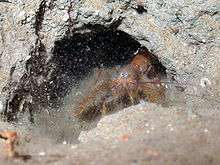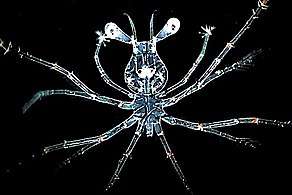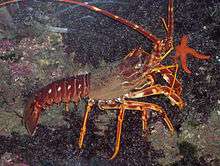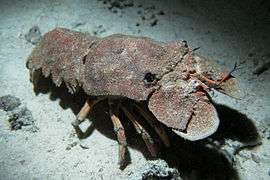Achelata
The Achelata is an infra-order of the decapod crustaceans, holding the spiny lobsters, slipper lobsters and their fossil relatives.
| Achelata | |
|---|---|
 | |
| The phyllosoma larva is characteristic of the Achelata (drawing by Haeckel) | |
| Scientific classification | |
| Kingdom: | Animalia |
| Phylum: | Arthropoda |
| Subphylum: | Crustacea |
| Class: | Malacostraca |
| Order: | Decapoda |
| Suborder: | Pleocyemata |
| Infraorder: | Achelata Scholtz & Richter, 1995 |
| Families [1] | |
Description
The name "Achelata" derives from the fact that all the members of this group lack the chelae (claws) that are found on almost all other decapods (from the Greek α-, a- = "not", χηλή, chela = "claw"). They are further united by the great enlargement of the first antennae, by the special "phyllosoma" form of the larva, and by a number of other characters.[2]
Classification and fossil record
Achelata contains the spiny lobsters (Palinuridae), the slipper lobsters (Scyllaridae) and the furry lobsters (Synaxidae, now usually included in Palinuridae),[3] as well as two extinct families, Cancrinidae and Tricarinidae.[1]

Palinuridae, formerly Synaxidae

Both Palinuridae and Scyllaridae have a fossil record extending back to the Cretaceous.[4][5] The two fossil families contain a single genus each;[1] Tricarina is known from a single Cretaceous fossil,[6] while Cancrinos is known from the Jurassic and Cretaceous.[5] One estimate of the divergence between Achelata and its closest relatives places it at about 341 million years ago.[7]
References
- Sammy De Grave; N. Dean Pentcheff; Shane T. Ahyong; et al. (2009). "A classification of living and fossil genera of decapod crustaceans" (PDF). Raffles Bulletin of Zoology. Suppl. 21: 1–109. Archived from the original (PDF) on 2011-06-06.
- Gerhard Scholtz; Stefan Richter (1995). "Phylogenetic systematics of the reptantian Decapoda (Crustacea, Malacostraca)" (PDF). Zoological Journal of the Linnean Society. 113 (3): 289–328. doi:10.1006/zjls.1995.0011.
- Ferran Palero; Keith A. Crandall; Pere Abelló; Enrique Macpherson; Marta Pascual (2009). "Phylogenetic relationships between spiny, slipper and coral lobsters (Crustacea, Decapoda, Achelata)". Molecular Phylogenetics and Evolution. 50 (1): 152–162. doi:10.1016/j.ympev.2008.10.003. PMID 18957325.
- Francisco J. Vega; Pedro García-Barrera; María del Carmen Perrilliat; Marco A. Coutiño; Ricardo Mariño-Pérez (2006). "El Espinal, a new plattenkalk facies locality from the Lower Cretaceous Sierra Madre Formation, Chiapas, southeastern Mexico" (PDF). Revista Mexicana de Ciencias Geológicas. 23 (3): 323–333.
- Joachim T. Haug; Carolin Haug; Dieter Waloszek; Andreas Maas; Matthias Wulf; Günter Schweigert (2009). "Development in Mesozoic scyllarids and implications for the evolution of Achelata (Reptantia, Decapoda, Crustacea)" (PDF). Palaeodiversity. 2: 97–110.
- Rodney M. Feldmann; Ali Kolahdouz; Bijan Biranvand; Guenter Schweigert (2007). "A new family, genus, and species of lobster (Decapoda: Achelata) from the Gadvan Formation (Early Cretaceous) of Iran" (PDF). Journal of Paleontology. 81 (2): 405–407. doi:10.1666/0022-3360(2007)81[405:ANFGAS]2.0.CO;2. Archived from the original (PDF) on 2016-03-04. Retrieved 2012-02-05.
- Keith A. Crandall; Megan L. Porter; Marcos Pérez-Losada (2009). "Crabs, shrimps and lobsters (Decapoda)". In S. Blair Hedges; Sudhir Kumar (eds.). The Timetree of Life. Oxford University Press. pp. 293–297. ISBN 978-0-19-160898-8.
External links


